Everything about aquariums: types, selection and application
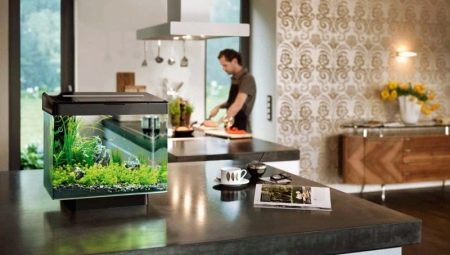
An aquarium can be a good home decoration. The main tank contains fish with plants and decorations. Additionally, specialized aquariums are needed for the treatment or breeding of inhabitants.
It is important to correctly arrange and populate the container. With the right approach, a decorative aquarium will delight and not be a hassle.
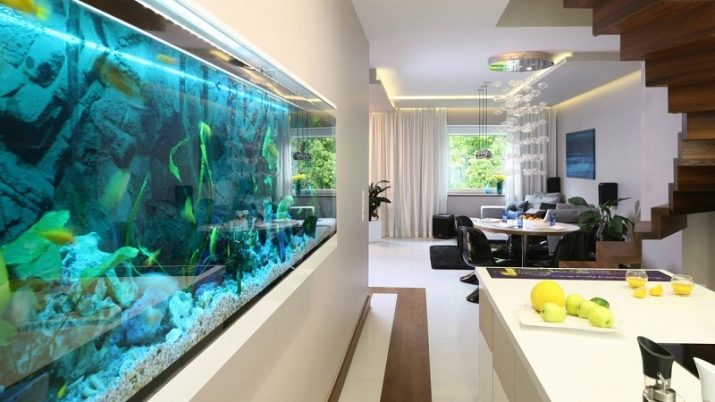





Features and purpose
Aquariums can serve a variety of purposes. Professionals distinguish between many types of reservoirs based on who and what they are inhabited. Aquariums for their intended purpose can be of several types.
- General. Suitable for home use, suitable for beginners. In such an aquarium, you can collect many different beautiful fish and plants, snails and other inhabitants. The goal is only in the beauty of the general appearance.
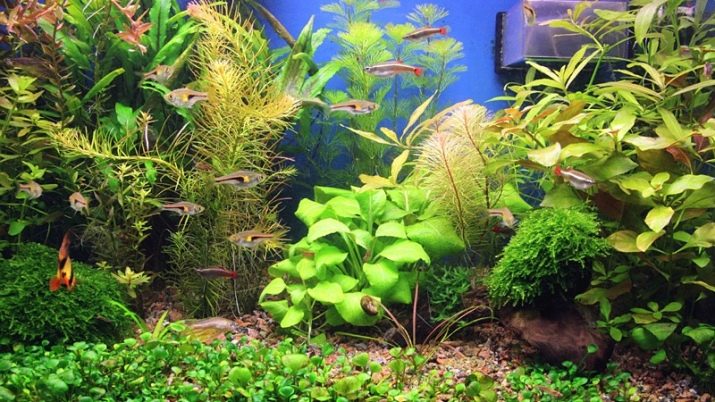
- Collectible. Inhabits fish of different species, but of the same family. For example, you can populate a reservoir with cichlids using flocks of cancers, melanochromis and scalars.
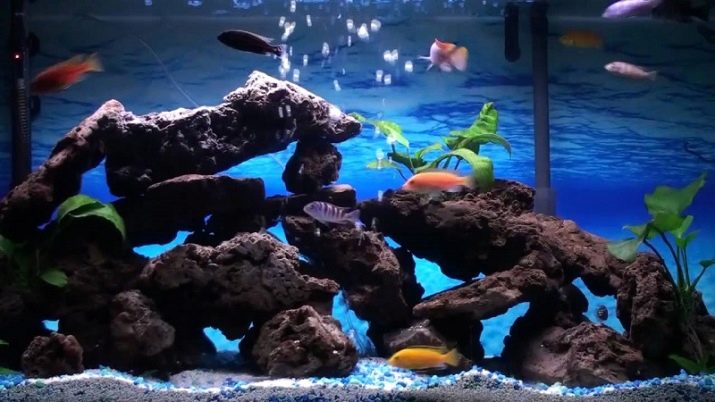
- Geographical. Recreates the geography of the underwater world. Decorated in ethnic style. Maximum realism is achieved with back wall stickers and decorations.
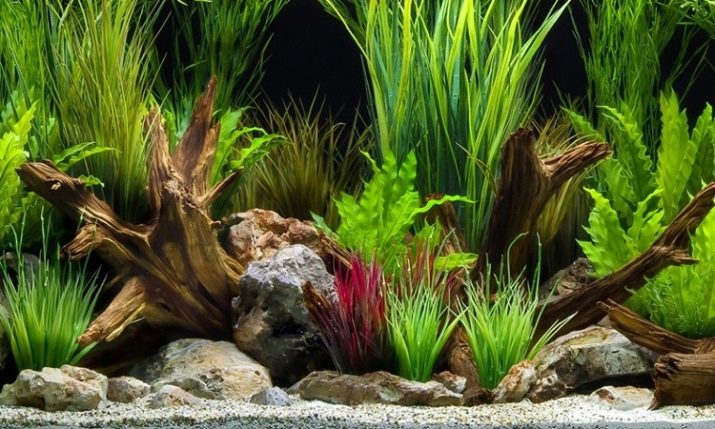
- Decorated outdoor. An aquarium without a lid is decorated with plants, fountains. Decorations can go beyond the water.
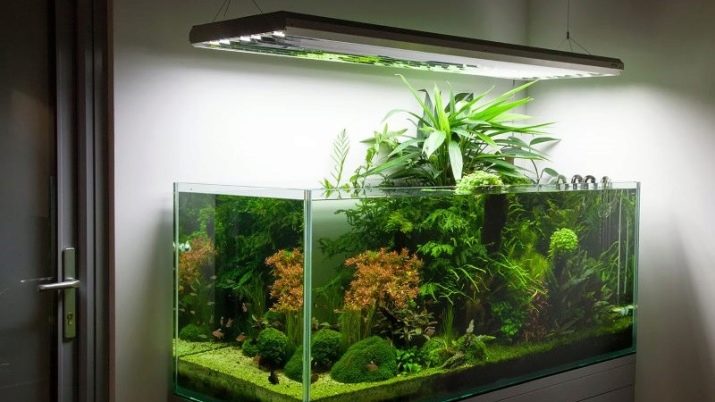
- Species. Inhabits fish of related species. Designed to study behavior and interaction.

- Biotope. The aquarium is filled with fresh water and stocked with tropical fish. A detailed copy of an arbitrary area of a natural biotope is recreated.It is worth choosing those types of fish that live in one place in complete harmony with each other.

- Dutch. Contains a lot of plants, but there may be no fish at all. The oblong-shaped container duplicates the landscape design of the sea depths.
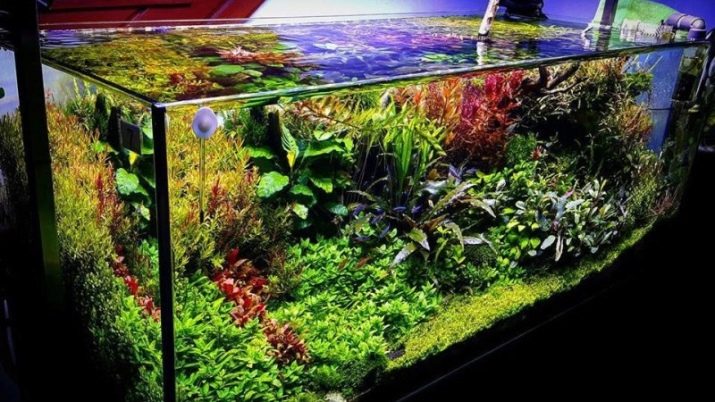
- Paludarium. The emphasis is on the combination of aquatic, terrestrial and marginal plants. You can add fish or shrimp. It is advisable that the inhabitants of the reservoir do not eat algae.
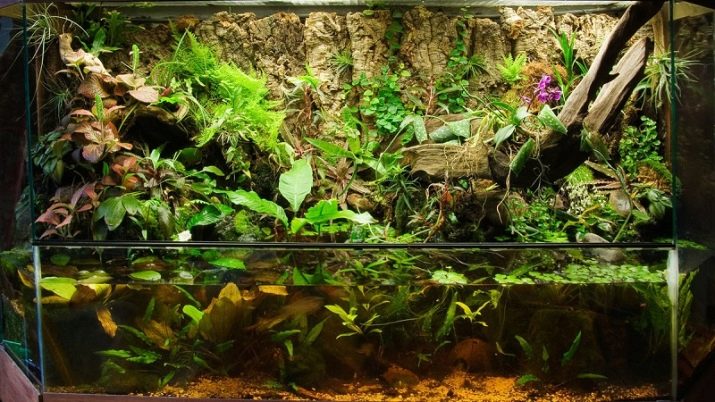
- Aquaterrarium. It is inhabited by animals that can live both on land and in water. It is a kind of symbiosis between a terrarium and an aquarium.
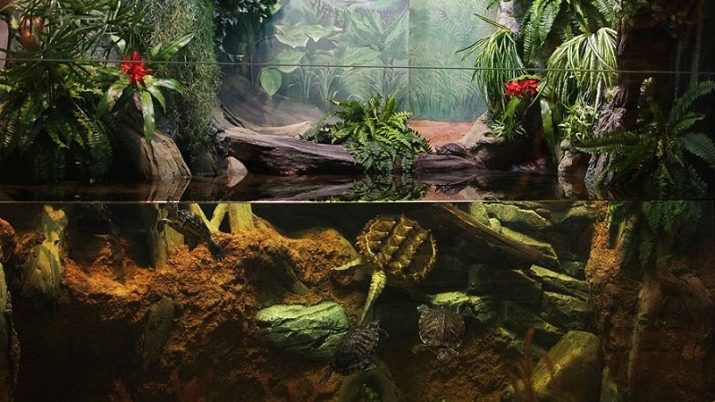
- Nano aquarium. A miniature container with unpretentious and attractive fish and plants.
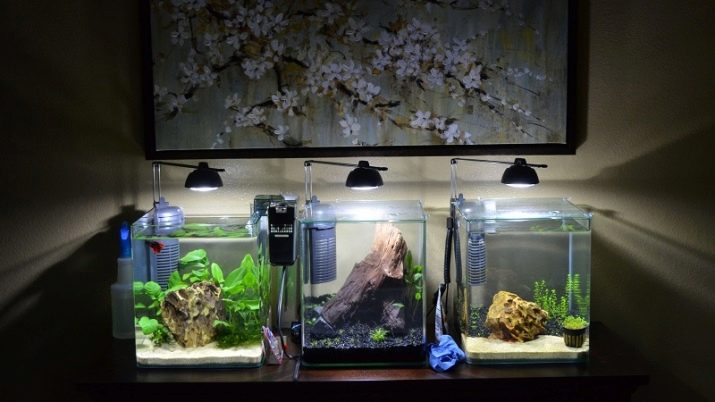
- Japanese Amano. Decorated in a minimalist style. Reproduces the ecosystem and landscape features of the Amazon.
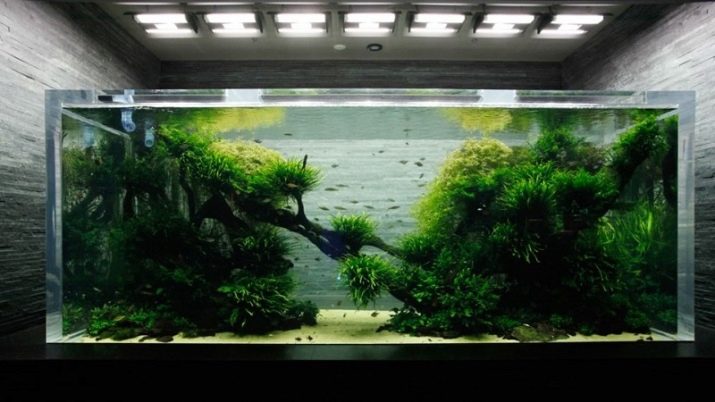
- Mixed. A subspecies of a home aquarium that combines a variety of fish and plant species. Can be decorated with any decor.

The aquarium complex can serve not only for decoration, but also for a serious purpose. It is convenient to use small rectangular tanks. They can even be made of plastic.
Specialists divide special aquariums into several types.
- Spawning. Designed for fish farming. This container is always sterile. It creates optimal conditions for a specific type of fish.
- Incubators. Needed for the maintenance and development of larvae, eggs.
- Insulators. Jump tanks are needed to treat sick fish or adapt new ones.
- Growing up. They look like troughs and are needed for the fry to mature. This aquarium is used after spawning.
- Cultivators. Feeding aquariums allow fish owners to breed live complementary foods on their own.
- Breeding. Needed by specialists to breed new fish species.
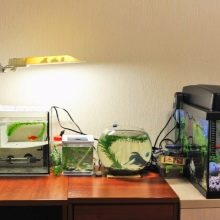
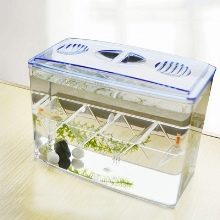
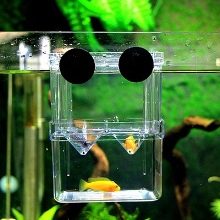
Types of structures
Beautiful free-standing or built-in aquariums are becoming the centerpiece of many homes. All of them are divided into types depending on the design and manufacturing technology. Usually expensive asbestos-cement aquariums are installed in furniture; they can even be tiled or plastered. For manufacturing, cement, water and asbestos fiber are used.
Newbies for home use choose the more affordable options. Frame and frameless structures are the most popular. Seamless circular patterns are considered harmful to the inhabitants due to the distortion of space.
In the selection process, it is worth relying on the advantages and disadvantages of a particular design.
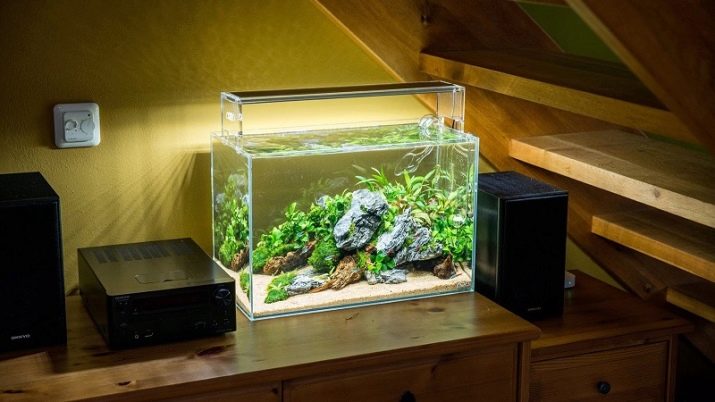
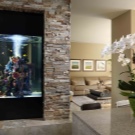
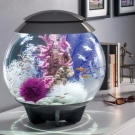
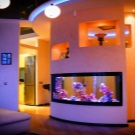
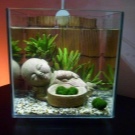

Frameless
Silicate or organic glass is used for manufacturing. The latter is durable and does not affect the composition of the water in the aquarium. Acrylic glass does not tolerate mechanical stress. There is a great risk of scratching it, and over time, transparency may disappear.
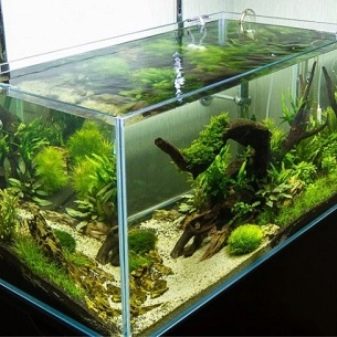
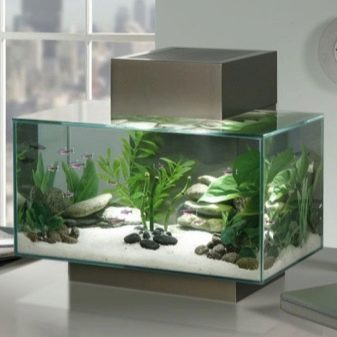
Wireframe
For manufacturing, a metal frame is used. This aquarium can be of any size. If the container is not used for a long time, it becomes unusable. The sealed putty dries and crumbles, leaks appear.
In addition, the sealant can negatively affect the composition of the water, so this type is not suitable for keeping marine fish.
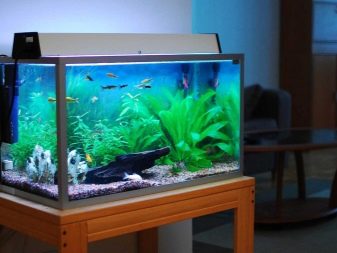
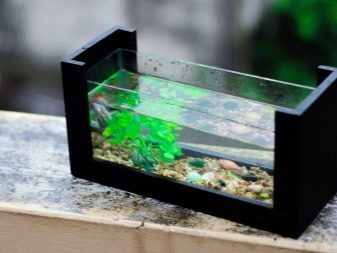
Seamless
Plexiglass is used for manufacturing. Tanks can have any shape, and this is what attracts many amateurs. Associated with round structures for keeping goldfish. It is worth noting that curved glass containers have been banned in some regions of Italy since 2006. In such a tank, only species of crucian carp can be kept, for other fish the distorted space destroys the psyche.
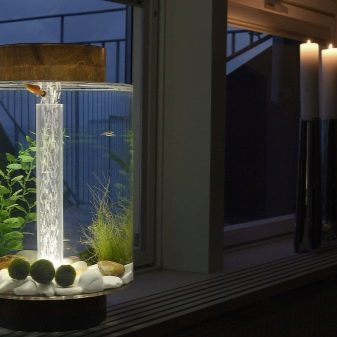
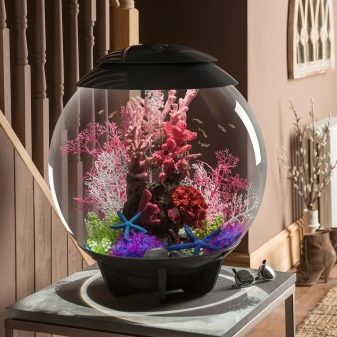
Manufacturing materials
The aquarium can be made of different materials, the durability and features of use depend on it. Let's consider the main options.
- Glass. Frameless and frameless aquariums are strong and durable, but they have an impressive weight. The stand should be as strong and stable as possible.
- Acrylic. The material has become popular relatively recently. Light weight, reliability, a wide range of shapes and a spectacular appearance make acrylic models a favorite among aquarists.
- Plastic. This material is lightweight and inexpensive, but the benefits end there. Plastic aquariums quickly become covered with minor scratches and cloudy with use. The volume is limited to 20 liters due to its low strength. Plexiglass or plastic can melt due to strong lighting or heat. Usually only used for the special tank, not the main one.
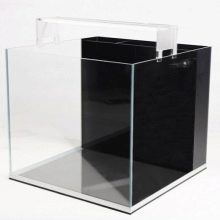
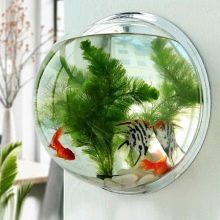
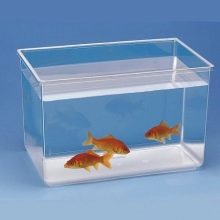
Forms
A rectangular or square aquarium is considered standard. Lovers of the unusual can choose beautiful curly designs in the form of vases, guitars, animals and more. For each shape, there are special supports that are designed for a specific load. Aquariums can be divided into the following types.
- Panoramic. The increased viewing angle is found in decorative aquariums and allows you to enjoy an interesting view. The fish can be seen from anywhere in the room.
- Corner. They are used in small rooms and have a triangle, hemisphere or trapezoid at the base. They take up little space and look stylish.
- Cylindrical. They require especially competent placement, otherwise there will be visual distortions. Beautiful vertical aquariums are usually placed on a matching pedestal in the middle of the room.
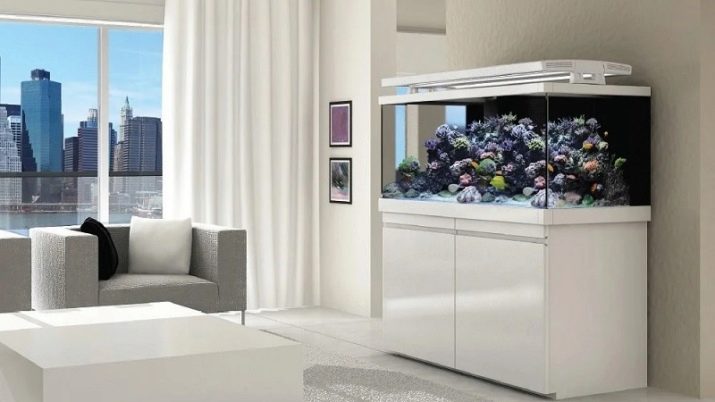
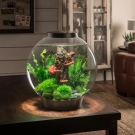
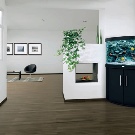
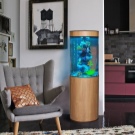
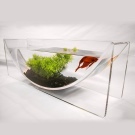
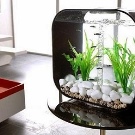
Dimensions (edit)
The volume of the aquarium can be absolutely anything - from one liter to several thousand. The size is selected based on the characteristics of the inhabitants of the tank. The number of fish and their needs indicate what kind of home they need. Small aquariums require more attention to the composition and condition of the water. In large ones, you can create a whole ecosystem that will cleanse itself on its own, as in nature.
Small
The aquarium holds up to 25 liters of water. Suitable for keeping small numbers of fish. You can keep unpretentious inhabitants in it, for example, cockerels. One individual needs only 0.5 liters, which means that a 5 liter aquarium is quite enough for a small flock. Models in the form of a ball and a rectangle are popular.
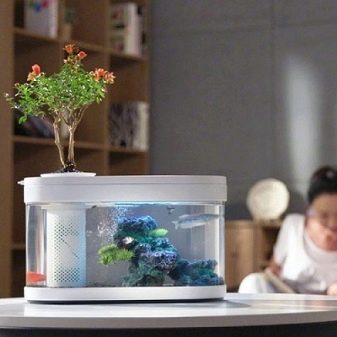

Average
The aquarium holds 25-100 liters of water. Models for 70, 80 and 90 liters are considered popular. The volume is quite enough for setting interesting decorations and keeping several schools of different fish with plants. Usually in houses they put just such aquariums made of glass or plastic.
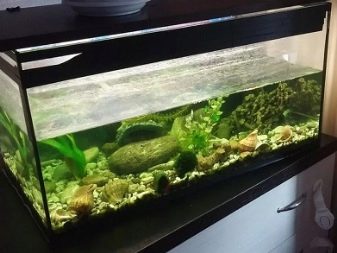

Big
Such an aquarium holds more than 100 liters. The most popular models are considered to be 120, 140 and 250 liters. Large-volume aquariums for 400, 600 liters are made to order and often harmoniously fit into the interior of the house. You can make a beautiful decorative partition or a column with an aquarium in the middle of the room.
It should be borne in mind that some fish care about depth, while others - the size of a flat bottom.
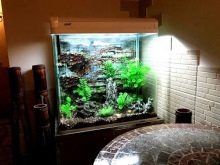
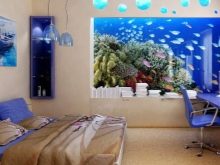

Types of water composition
The aquarium can be inhabited by both freshwater and marine life. Not only the species of fish and plants depend on the composition of the water, but also the equipment that will maintain the necessary conditions. Accordingly, the types of aquariums can be different.
- Freshwater. Popular aquariums with lake and river fish, plants. It is quite easy to maintain such an artificial reservoir. Can be of any size and shape.
- Marine. Designed for plants and fish living in salt water. They are distinguished by a large volume, because the inhabitants are quite large. Grooming is difficult because you need to maintain the correct chemical composition of the water.
- Brackish. An intermediate species for keeping the inhabitants of certain estuaries and bays.
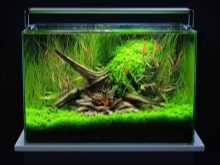
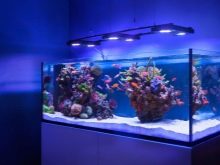
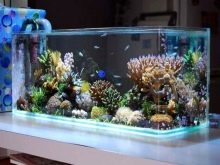
Necessary equipment
The maintenance of the optimal state of the ecosystem is carried out with the help of special devices. The equipment allows you to purify water, supply it with oxygen, maintain the desired temperature and lighting level. To equip your aquarium, you need to purchase a number of devices.
- Lamps. Light is needed to regulate the life of the inhabitants of the aquarium and to comfortably observe the fish.
- Heater. You need to heat the water to the desired temperature with a device with a thermostat.
- Thermometer. Allows you to control the temperature of the water.
- Aerator. The compressor distills air, enriching the water with it.
- Aquarium filter. Purifies water from organics.
- Skimmer or skimmer. Clean the surface of the water. Both separate foam and reduce the rate of algae development.
- Pump. Creates an artificial current.
- Timer. It will allow you to feed the fish in time and remove food debris.
- Siphon. Allows you to manually clean the soil in the aquarium.
- Controller for measuring pH. Allows you to monitor the quality of water.
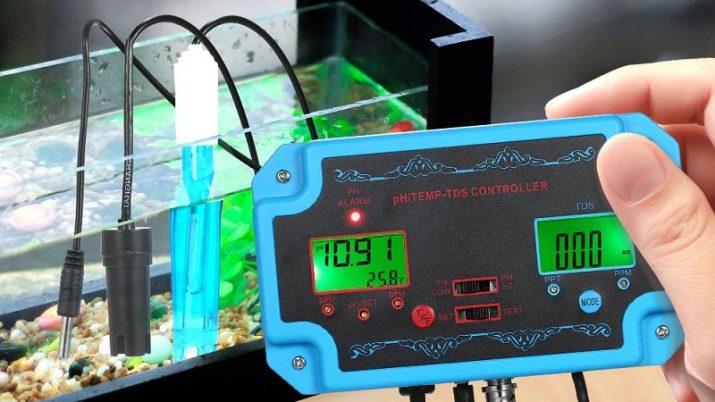
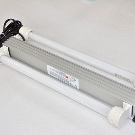
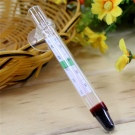

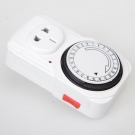
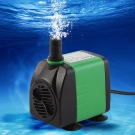
It is worth noting that some consumables will be required.
The filter periodically requires replacement of the check valve. Light bulbs need to work well, so they need to be updated too. Lack of light can lead to illness of the inhabitants of the aquarium. When cleaning the aquarium, it is worth inspecting the equipment for faults.

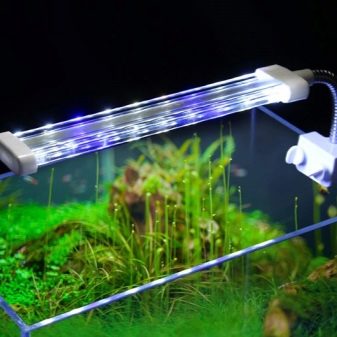
Self-cleaning models
Every day the aquarium pleases the owners with a beautiful view. However, the container needs to be cleaned regularly, which is quite troublesome. Self-cleaning models can be used to avoid inconvenience. Avo and My Fun Fish aquariums with self-cleaning system are the most popular in this area. They have a number of features.
- Avo. LED backlight regulates the processes of photosynthesis. Algae that pollute the water simply die. In the morning, the aquarium is highlighted in red, in the evening - in white, and at night - in blue. The filter creates a flow. The heater maintains + 27 ° C, which is suitable for many types of tropical fish.
The volume is only 15 liters. The tight cover prevents dust from entering.
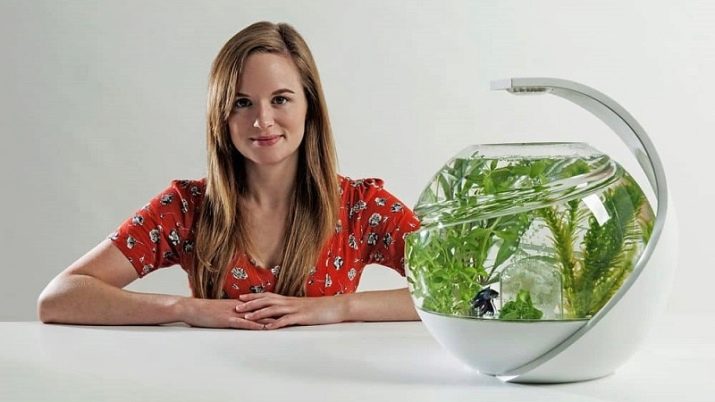
- My Fun Fish. More suitable for keeping aquarium plants. Periodically, you need to add fresh water to it. The tube provides the exit of water with sediment, it is simply displaced by fresh liquid.
Lower algae die because they have nothing to feed on. You can put a fish inside, but it should be borne in mind that the volume of the tank is only 2 liters.
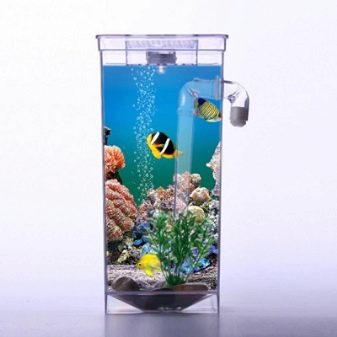
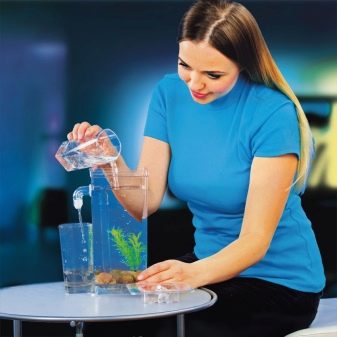
You still need to wash such aquariums, but much less often. If you do not do this at all, then the walls will begin to turn green and cloudy. The water should be fresh and should be changed at least once every couple of months.
If a fish lives inside, then it is worth carefully removing food debris after feeding.
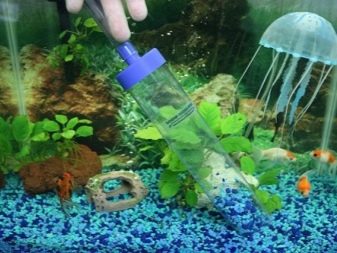
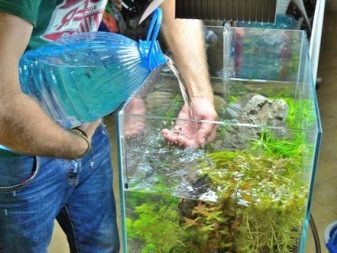
Lighting
Fish need a long day of light, about 8-12 hours. You need to turn on and off artificial lighting at about the same time. You can use automatic timed outlets to get rid of this hassle. Consider different lamp power based on the number of watts per liter of pure water volume.
- 0.1-0.3 W / l. Plants in such an aquarium will not survive.
- 0.2-0.4 W / l. Essential lighting for dwellers who are accustomed to living in the shade at great depths.
- 0.4-0.5 W / l. Suitable for an aquarium with fish and some algae.
- 0.5-0.8 W / l. An excellent solution for a decorative aquarium with live plants. Most algae do well in these conditions.
- 0.8-1 W / l. So much light is needed for a container with a dense planting of algae.
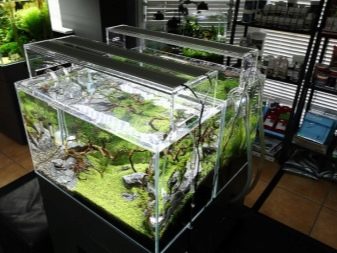
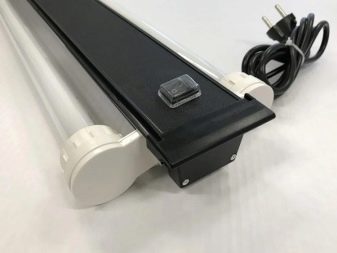
It should be noted that the values are approximate. Much depends on the shape and volume of the aquarium, the surface area of the water. The light source must also be selected correctly. Conventional incandescent lamps not suitable because they give little light and a lot of heat.
Luminescent light sources are the most suitable. They are affordable. The main thing is to choose exactly aquarium lamps, they have a wider spectrum of glow. It is worth choosing those that are marked with the T5 or T8 marking.
Metal halide lamps are used by professionals for large aquariums. It is noteworthy that they must be installed at a distance of 30 cm from the surface of the water.This is because lamps generate a lot of heat. An aquarium with such lighting looks magical, you can see glare in the water column and the shadows of fish.
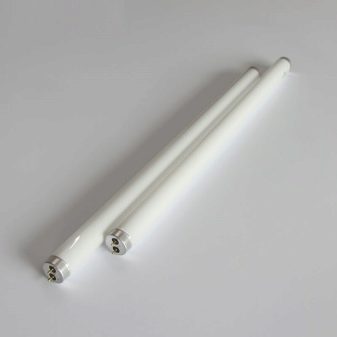
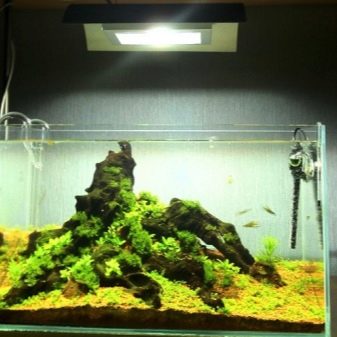
LED lights They practically do not heat the water and only slightly heat up from behind, so they can be placed under the aquarium lid. The cost of quality panels is high, but the quality of the lighting is worth it. The advantage is low voltage operation, which guarantees safety. It is important to purchase lamps in specialty stores so that they match the light spectrum of the aquarium.
Mixed lighting can be used. Usually, metal halide lamps simulate the peak of solar activity for a couple of hours, while LED or fluorescent lamps serve as lighting for the rest of the time. You just need to duplicate the natural living conditions of fish and plants that live in the aquarium.
Make sure that the light sources do not heat the water.

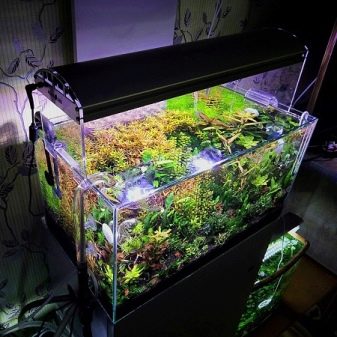
Aquarium inhabitants
Decorative artificial reservoirs must have their own inhabitants. There can be quite a few inhabitants of a home aquarium.
- Fishes. For decorative purposes, the following families are most often kept: haracin, carp, pecilia, cichl and labyrinth (osphroneme). Fish are the most common inhabitants of aquariums and many aquarists set up the conditions for their maintenance.

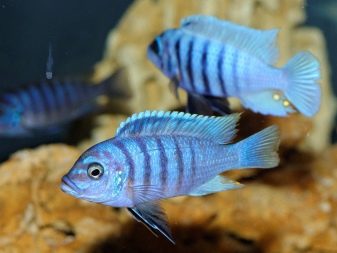
- Reptiles. Turtles can be kept in the aquarium, the most popular are Trionix and Red-eared. Keeping them together with fish is not worth it. Adults will simply eat their neighbors. For the turtle, you need to equip a place where it can go on land and breathe air.
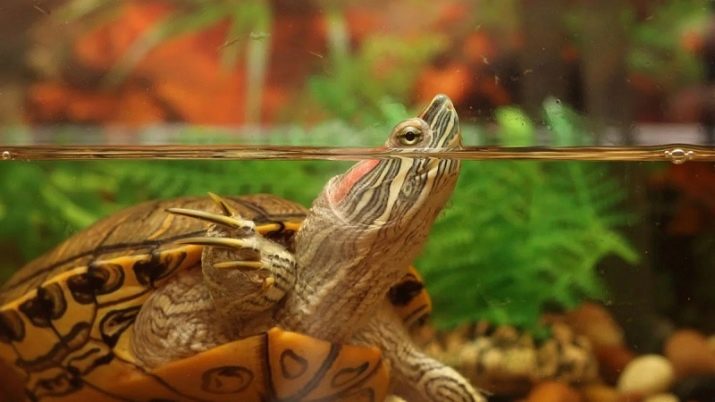
- Amphibians. The following species usually settle in aquariums: axolotls, clawed frogs and newts. The former are ambist larvae, but rarely turn into an adult. It is them that cannot be kept with fish. The ambistoma will eat small inhabitants, and the large ones will harm its gills.
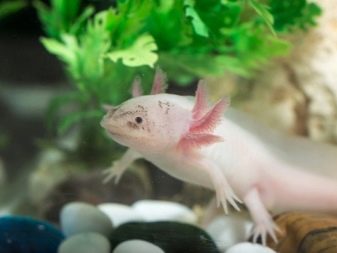
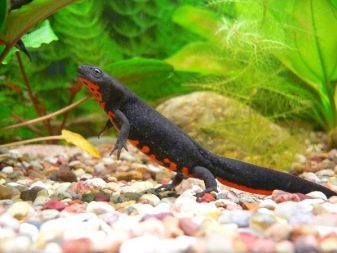
- Shellfish. Usually we are talking about snails, the most common are acrolux, ampullia. You can also contain bivalve molluscs, for example, pearl barley. They work well with fish and help keep the aquarium clean. Snails eat up excess food and some organic matter, which leads to rapid water pollution.
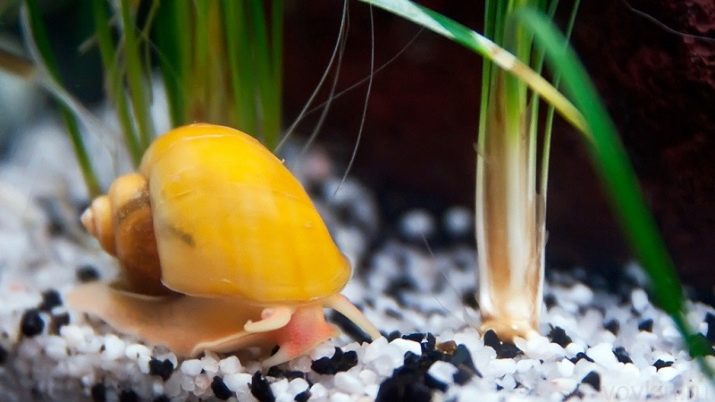
- Crustaceans. Crayfish and shrimps can only live in a separate aquarium, without fish. The latter will either become hunters during the crustacean molt, or they themselves will suffer. Triops and many shrimps live better in distilled water.

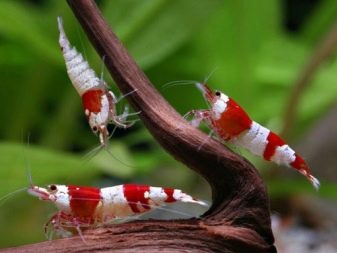
How to choose?
Experts recommend getting a medium-sized aquarium to get started. This is easy to maintain and arrange. Moreover, you do not have to worry about the crowds in the inhabitants. The optimal tank height is considered to be 40 cm, this is how the ecosystem will develop as harmoniously as possible.
You can choose any shape. Rectangular aquariums are considered the standard and most convenient. It is worth abandoning models with convex glasses - they have a bad effect on the fish.

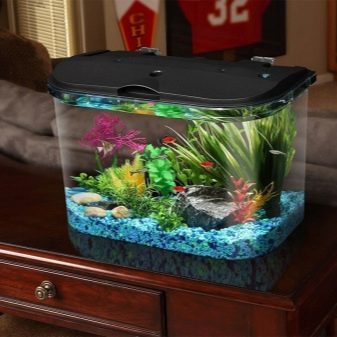
The choice of material directly depends on the size of the tank. Here are some expert tips.
- Virtually scratch-resistant glass and transmits light well.
- The cost of an acrylic aquarium is quite high. It is easy to scratch, but difficult to break.
- Plastic models are not suitable for keeping fish on a permanent basis. However, they will be a good option for temporary jigging.
- When choosing a frame product you should pay close attention to the quality of the sealed putty. Moreover, salt water should not be poured into such an aquarium.
It is recommended to buy aquariums from well-known manufacturers in specialized pet stores. It is necessary to check the product for leaks even before planting fish in it.
Additionally, you need to purchase a cover or cover glass. The latter should be slightly larger than the aquarium.
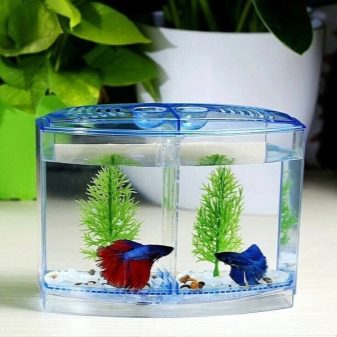
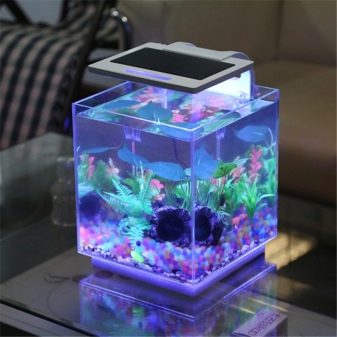
How to carry out transportation?
Transportation may be needed both when buying an aquarium and when moving.If the model is large, then it is better to entrust the matter to specialists. Some organizations transport aquariums with water and fish, which is quite convenient. Transportation rules include several points.
- It is important to clearly think over all the nuances in advance. Fish should not be outside the main aquarium for a long time, otherwise the stress will be too great.
- It is necessary to plant fish, remove soil and plants. It is important to retain about 60-70% of the old water and pour it back into the tank after transport.
- You need to pack the aquarium with bubble wrap, cardboard, foam rubber. If the aquarium is large, it is best to hire a packaging specialist.
- It is important to act carefully and quickly when loading and unloading. The aquarium should not be dropped or hit in the process.
- The large tank in the vehicle must be secured with straps.
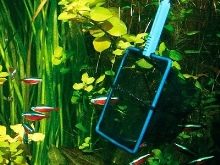

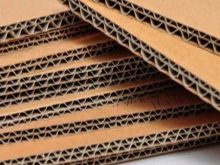
Large and heavy aquariums are transported in trucks. Sometimes you may need a car with a hydrolift. The lift will provide smooth lifting and lowering of fragile loads. A small aquarium can be easily transported in a car.
The reservoir must be securely fastened in the trunk or in the back seat so that it does not get damaged on bumps or when turning.

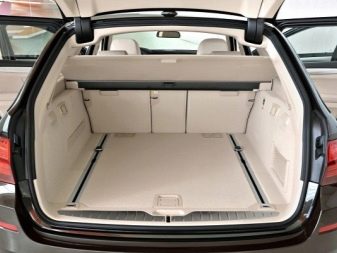
Where to put it?
The aquarium allows you to create a corner of peace with high decorative properties. Observing the aquatic inhabitants is soothing and pleasant. Let's list the factors for choosing a place to place an aquarium.
- Convenience of observation. You need to put the aquarium in a recreation area so that you can observe it. If this is not possible, then try to use a bright design so that even a quick glance is enough to attract attention. Make sure that large furniture does not obstruct the tank.
- Features of care. The aquarium should not be placed near a battery or a window, otherwise the temperature regime will be unstable. There should be no objects near the tank that cannot tolerate moisture. Free space must be left on top of the tank so that it is possible to work inside the tank.
- Electricity. Water and electrical appliances combine to create a situation of constant danger. Protect all outlets from moisture. Electrical appliances must be connected safely and not in one place. Aquarium equipment requires a ground connection.
- Noisiness. The aquarium in the bedroom will create noise. If you still want to put it there, then you should choose quiet modern equipment.
- Floor load. A large floor aquarium can be potentially hazardous in an apartment setting. It happens that load-bearing ceilings in a multi-storey building are simply not able to withstand the load that the reservoir provides.
- Unusually shaped reservoirs. The aquarium table can be placed near the sofa and used as a coffee or coffee table. The tower will decorate the interior and save space. The partition aquarium can be used for room zoning.
- Space around. There should be free space on all sides, especially at the back of the aquarium. This is necessary for free placement of equipment.
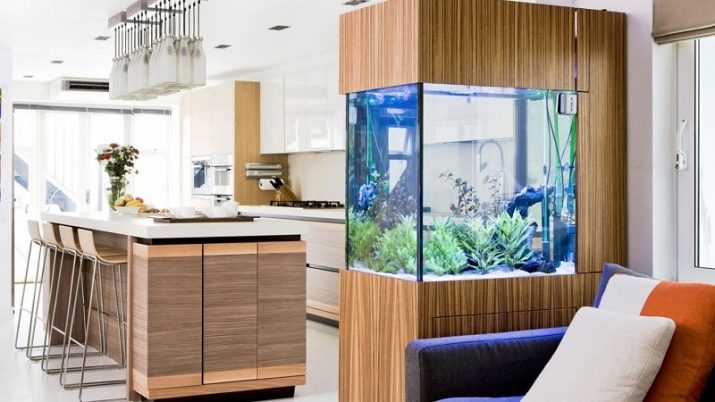
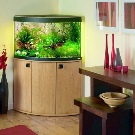
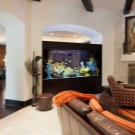
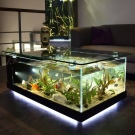
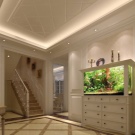
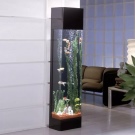
The tank must be installed on a stand. As standard it reaches 70 cm in height and is suitable for seated fish watching. If the aquarium is located so that you can only look at it while standing, the cabinet should be 110-120 cm high.
It is important that the gaze falls perpendicularly to the front wall or slightly from above. It should be borne in mind that the aquarium stand must support the required weight.
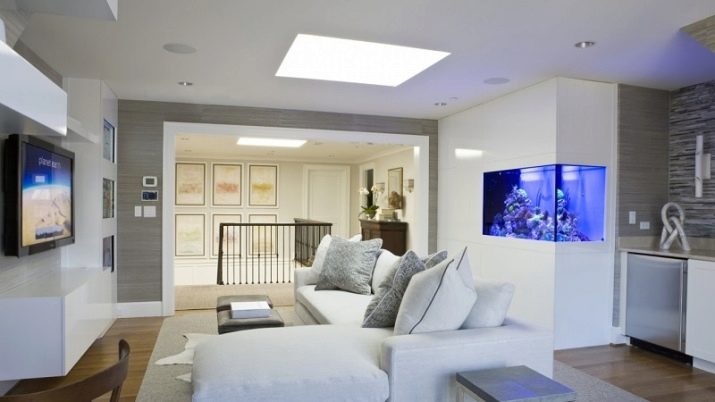
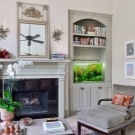
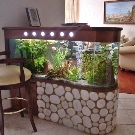
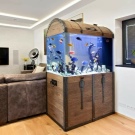
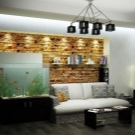
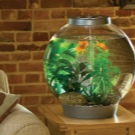
Correct start
It is difficult to set up and restart an aquarium after the water has already been poured. Experts advise starting the aquarium correctly from the very beginning.
- The cabinet must be sized to support the weight of the aquarium. It is worth making sure of this in advance. With the help of a building level, you need to check if the surface is skewed. The edges of the container should not hang over the cabinet.
- If you plan to pasting the back wall with a background, then you need to do this at this stage.Glass should be thoroughly degreased and then decorated.
- You need to put a stand, a rug on the curbstone. It will absorb vibration and distribute the load evenly.
- Laying the soil requires preliminary cleaning. It is better to do this under running water so that the litter is washed out under pressure. The filler can be laid unevenly. If you plan to plant live algae, then the layer should be at least 6-8 cm.
- It should be checked with the help of a building level, how level the tank is. If necessary, adjust the position. Misalignment will result in increased wall loading, which will cause leakage.
- Water should be poured in slowly, without eroding the soil. The liquid should first be defended or added to it with a cleaner from the pet store. A hose can be used to fill in the water.
- You need to pour in water so as to leave a couple of centimeters on top. This space will eventually be occupied by decorations.
- It is worth adding a special conditioner to the water so that the chlorine comes out.
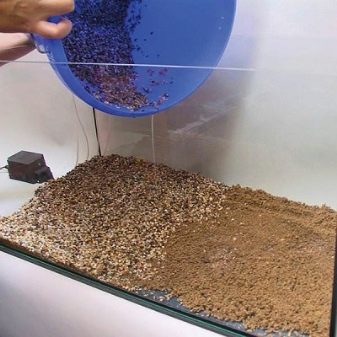
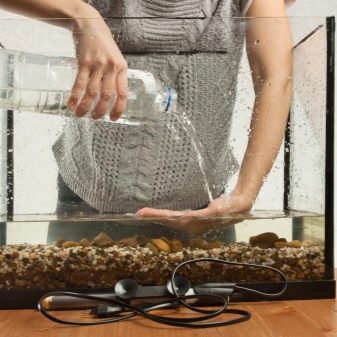
It's time to test the equipment's performance. The heater is installed near the filter where there is flow. This is necessary for uniform heating. The heater must be completely immersed in water; the device must not be buried in the filler. Set the required heating temperature and check the result with a thermometer.
The filter with the compressor is installed at the very bottom, where dirt accumulates. If aeration is needed, then it is necessary, on the contrary, to raise the device closer to the surface. Before installation, you should read the manufacturer's recommendations. Air will come out of the filter during the first 2-3 hours, this is normal.
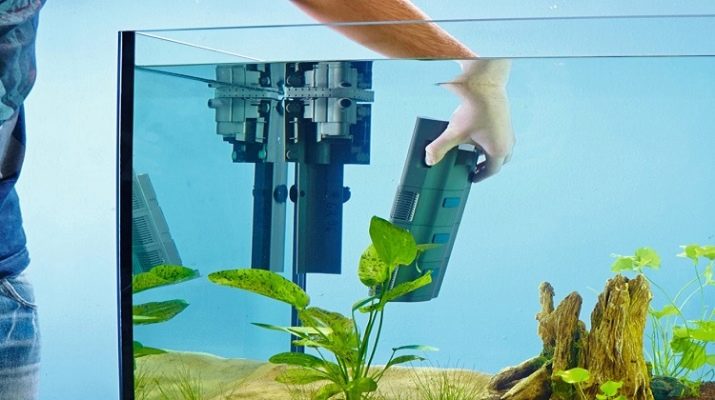
When connecting an external filter, follow the instructions. The pipes for the intake and outlet of water must be installed at different ends of the tank. This will prevent the water from stagnating. It is better to place the fence near the bottom and be sure to equip it with a pre-filter. Otherwise, an inhabitant of the aquarium can get into the tube.
Setting up the scenery requires preparation. All snags and locks need to be washed and boiled. If a piece of wood floats, then soak it in water before immersion in the aquarium. Large tanks under heavy decorations need to be filled with Styrofoam. All decorative elements must be carefully fixed.
You can plant fish at least 3-4 days after installing the scenery. During this period, the water will warm up and be purified. At this time, it is worth adding a powder or liquid that will colonize the beneficial bacteria. They will settle in the soil and in the filter, and will purify the water throughout its entire service life.
Plants can be planted even before the fish. Just make sure that the water warms up to + 24 ° C. In a few days the turbidity will settle down, the water will become clear. Then you can already populate the inhabitants.
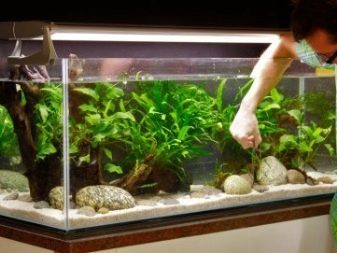

Design ideas
The aquarium should delight with its appearance. Decor goes a long way towards creating a harmonious look.
- Gravel, sand, pebbles can be used as soil. In a large aquarium, the bottom can be lined with stones. Pet stores have special decorative glass pebbles that look especially interesting. There is lava for decoration, these are also artificial stones.
- Some of the decorations can be assembled by yourself. Alder cones, driftwood, and seashells work well. Beforehand, everything should be washed and boiled.
- You can make an interesting sandfall on your own. The sand should be picked up empirically so that it does not scatter around the aquarium.

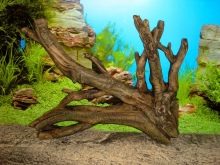

Fake plants and aquarium decorations can be purchased at pet stores to create amazing compositions. Today, there are several popular tank design styles.
- Dutch. Lush and sad seaweed becomes the center of the composition. About 12 plant species are used. Everything is planted in groups according to color and growth rate. Plants need to be pruned and fed regularly.
- Natural. The landscape of a specific area is imitated. The composition can be based on a lake, mountains, forest, ocean. Asymmetrical shapes and at least 5 plant species are used.
- Rock garden. Pebbles of a similar type and shape are laid at the bottom. The style is rarely used by beginners.
- Pseudo-natural. Created by combining soil, plants and fish. Novice owners use just such a design style.
- Pseudo-sea. Used shells and shell rock instead of the usual soil. You can find corals of the right size. The main thing is to simulate the bottom of the sea or ocean as realistically as possible. The name of the style is due to the fact that the water in the aquarium is fresh.
- Collection. More than 15 types of algae are planted in the aquarium. Unlike the Dutch style, this can deviate from the rules and not adhere to the principles of grouping.
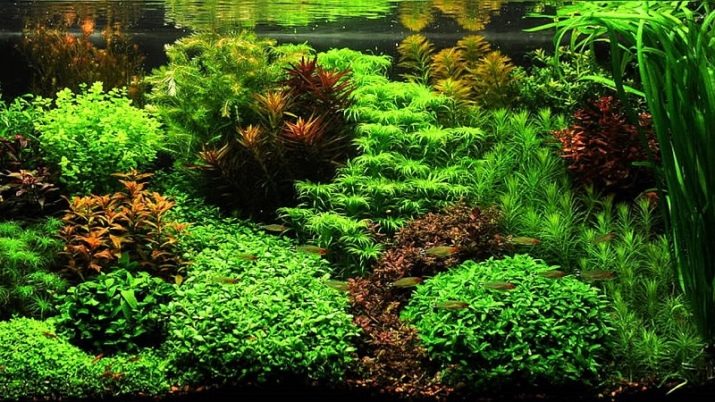
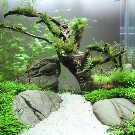
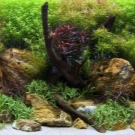
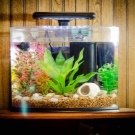
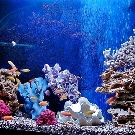
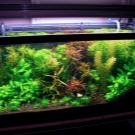
Operation and care
Using an aquarium for decorative purposes requires a responsible approach. Each owner must remember a few rules.
- Stability. Do not move the aquarium with water even a centimeter. Be sure to first drain most of it. Otherwise, a leak or even a crack may appear.
- Feeding. This procedure is performed once a day, and the first time you need to use a timer. The portion should be eaten in 5-7 minutes, the leftovers should be removed. Large amounts of leftover food will rot and lead to water spoilage and disease.
- Lighting mode. Living plants need lamps for 10-12 hours, and if there are none, then daylight hours are reduced to 8-9 hours. In this case, you need to use only high-quality lamps that do not heat the water.
- Temperature. The thermostat is set to the desired position once and must work constantly. Every day, you should check the temperature of the water with a thermometer. Before removing the device from the aquarium, you must disconnect it from the power supply.
- Filtration. Water purification equipment must work around the clock. The maximum allowed break is 3 hours. Otherwise, fish and plants may begin to die due to microclimate disturbance.
- Water composition. The hardness and acidity should be monitored. If necessary, it is important to immediately adjust the composition of the water, otherwise all the inhabitants will start to get sick. Activated carbon can be used to remove heavy salts.
- Compatibility. It is important to select fish and algae so that they fit each other in terms of habitat. Moreover, the combination of predators and carnivores will lead to the fact that the former will begin to hunt and eat the latter.
- Free space. Each inhabitant of the aquarium needs a certain amount of space to live comfortably. Overpopulation will trigger natural selection. The stronger fish will simply kill the weaker ones.


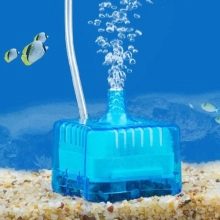
Cleaning the aquarium requires special attention from the owners. About 10-20% of the water should be renewed every week. Once every two weeks, it is necessary to rinse the filters under running water so that dirt does not accumulate inside. Do not use household chemicals to clean the tank and decorations. The soil is cleaned with a siphon, and the green plaque can be removed from the walls with a scraper.
You should pay special attention to plants. Only the right lighting contributes to the development of algae. CO2 supply and fertilization are of lesser importance. Gas consumption is directly dependent on the light that is supplied. The combination of the right amount of lighting, fertilizer and CO2 results in a lush and beautiful greenery growth. Air bubbles on the leaves indicate that the plants are in perfect order.
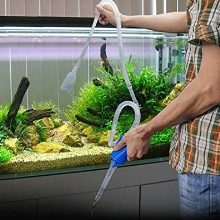
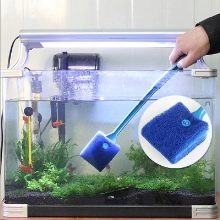
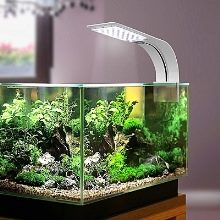
If bubbles are visible on the surface of the water, it means that there is a supersaturation with oxygen and the excess simply comes out.
In the following video, you will find useful tips for setting up and maintaining an aquarium for beginners.








